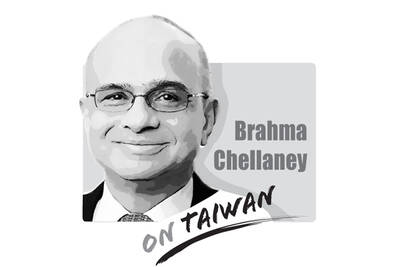It was 1981 when a young associate professor at Carnegie Mellon University, named Chen Wen-chen (陳文成), died — allegedly murdered by members of Taiwan Garrison Command — but the effect his death has had on Taiwan has not diminished with the passing of time.
To commemorate the incident, National Taiwan University is to dedicate a plaza on its campus to Chen, for which it held a design competition.
Blank Space, the winning design, features an opaque cube made of dark glass that allows people to see out from inside the cube, is a fitting monument for the incident due to its ghastly aesthetics, which according to its designers are to highlight the unanswered questions surrounding Chen’s death, giving it an almost “unreal” feel.
However, Chen’s death was very real and the facts about the incident are worth reviewing, lest people living in the free world forget for how long the pioneers of democracy fought to earn the freedom they enjoy today.
Chen, who had returned to Taiwan for a vacation, had allegedly been followed by the command for more than a month. He was detained on the grounds that he financially supported the pro-democracy Formosa Magazine and questioned the night before he was found dead outside the university’s library.
While the Chinese Nationalist Party (KMT) might think that it has come clean, as there was no “official” proof that Chen was murdered, it should not forget that society is capable of putting two and two together, making it almost evident who murdered Chen.
The then-KMT government said that Chen committed suicide in remorse for a criminal activity, only to backtrack when pressed by the media to explain what Chen’s supposed crime was.
The assumption that Chen was murdered was consolidated after US forensic pathologist Cyril Wecht performed an autopsy on his body, finding lacerations to his kidneys and signs of hemorrhaging in his lungs, indicating that he had been bludgeoned. There were no signs of defensive wounds, Wecht said.
Before leaving Taiwan, Wecht told reporters that Chen could have been knocked out or drugged and thrown off the roof of the library.
He also suggested that the Ministry of Justice run a toxicology test on Chen’s blood to ascertain whether he had been under the influence of drugs. However, the ministry turned down Wecht’s request, which painted the then-KMT administration in a bad light, and left Taiwanese at home and overseas perplexed and angry.
The Chen Wen-chen Incident left its mark in Taiwanese history, but it was not the last heartbreaking example of oppression.
Earlier this year, 28 years after the government lifted martial law, military police illegally raided the home of a civilian, surnamed Wei (魏), and seized documents he purchased online regarding the 228 Incident, which had allegedly been leaked by government officials.
In a sense, Wei had become another Chen, as both men were targets of atrocities perpetrated by those in power.
There have been many “Chen Wen-chens” throughout the nation’s history, such as painter Chen Cheng-po (陳澄波) and Massachusetts Institute of Technology-trained aerospace engineer Kuo Ching-chiang (郭清江), to name but a few.
The story of Chen Wen-chen’s death is more than a cautionary tale about the White Terror era. It is a story that should be told to the generations to come, to warn people of the danger they face when they are watched by the Big Brother and educate them about Taiwan’s hard-earned democracy.
It is a lesson every free person should take to heart.

As strategic tensions escalate across the vast Indo-Pacific region, Taiwan has emerged as more than a potential flashpoint. It is the fulcrum upon which the credibility of the evolving American-led strategy of integrated deterrence now rests. How the US and regional powers like Japan respond to Taiwan’s defense, and how credible the deterrent against Chinese aggression proves to be, will profoundly shape the Indo-Pacific security architecture for years to come. A successful defense of Taiwan through strengthened deterrence in the Indo-Pacific would enhance the credibility of the US-led alliance system and underpin America’s global preeminence, while a failure of integrated deterrence would
It is being said every second day: The ongoing recall campaign in Taiwan — where citizens are trying to collect enough signatures to trigger re-elections for a number of Chinese Nationalist Party (KMT) legislators — is orchestrated by the Democratic Progressive Party (DPP), or even President William Lai (賴清德) himself. The KMT makes the claim, and foreign media and analysts repeat it. However, they never show any proof — because there is not any. It is alarming how easily academics, journalists and experts toss around claims that amount to accusing a democratic government of conspiracy — without a shred of evidence. These
Taiwan is confronting escalating threats from its behemoth neighbor. Last month, the Chinese People’s Liberation Army conducted live-fire drills in the East China Sea, practicing blockades and precision strikes on simulated targets, while its escalating cyberattacks targeting government, financial and telecommunication systems threaten to disrupt Taiwan’s digital infrastructure. The mounting geopolitical pressure underscores Taiwan’s need to strengthen its defense capabilities to deter possible aggression and improve civilian preparedness. The consequences of inadequate preparation have been made all too clear by the tragic situation in Ukraine. Taiwan can build on its successful COVID-19 response, marked by effective planning and execution, to enhance
Since taking office, US President Donald Trump has upheld the core goals of “making America safer, stronger, and more prosperous,” fully implementing an “America first” policy. Countries have responded cautiously to the fresh style and rapid pace of the new Trump administration. The US has prioritized reindustrialization, building a stronger US role in the Indo-Pacific, and countering China’s malicious influence. This has created a high degree of alignment between the interests of Taiwan and the US in security, economics, technology and other spheres. Taiwan must properly understand the Trump administration’s intentions and coordinate, connect and correspond with US strategic goals.